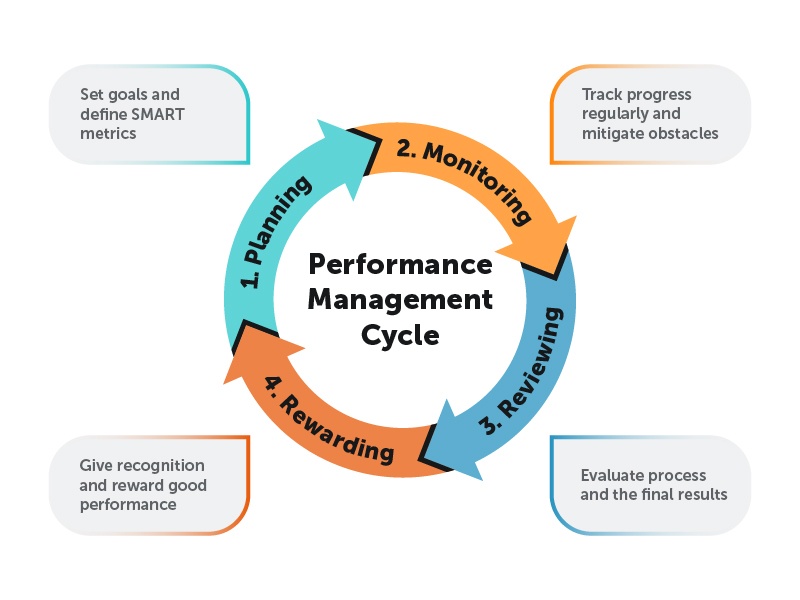Performance management cycle
What is a performance management cycle and why is it important in business? Understand the performance management cycle.

Discover:
- What is the performance management cycle?
- Why is the performance management cycle important in business?
- Stages of the performance management cycle
What is the performance management cycle
The performance management cycle is a model that allows management and employees to better achieve organizational goals through a structured process of employee development.
The performance management cycle is a part of the performance management process or strategy, it is shorter and utilizes a continuous four-step procedure of planning, monitoring, reviewing and rewarding.
Benefits of utilizing this method include increased competitiveness, more structural flexibility, and higher employee motivation.

The performance management cycle definition encompasses four main stages:
- Planning
- Monitoring
- Reviewing
- Rewarding
The model traditionally runs on a year-long timeline, ending with a performance review, although various organizations have found that more frequent check-ins will improve employee performance.
One of the benefits of integrating a proper performance management cycle plan is an employee who is more aligned with the goals of the organization, who understands both their own objectives and the larger objectives of the organization and has a solid roadmap that will help them achieve their objectives.
Why is the performance management cycle important in business?
By developing the performance management cycle plan an organization can maximize the output of their employees, ensure that organizational goals are being driven forward and concretely track the performance of each employee.
In following the performance management cycle model, an organization can also continually revisit its own structural goals, which allows for a quicker response to changing market forces. This flexibility means increased competitiveness.
Employees also benefit from the performance management cycle plan.
Through collaboration with and support from their management team, they see that they are a valued member of a team. Their skills are being developed and used in meaningful ways, and there is a reward for hard work.
All of those are factors in job satisfaction and will improve employee retention.

L&D strategy framework
You will receive a list of questions along with a spreadsheet template to help you analyse your L&D strategy.
DOWNLOAD FRAMEWORKStages of the performance management cycle
Let’s take a closer look at each stage of the performance management cycle.
1. Planning
In the planning stage, the groundwork for success is laid down. Before management talks to the employee, the management team should meet and decide the organization’s goals and objectives for the year.
This involves the overall strategy for the business, but also the personal objectives for all employees and teams, including development goals, specific tasks, targets, actions and behaviors.
Without that crucial information, any planning with employees will not be effective.
Once the management team knows the details of what they want the employee to achieve, it is time to meet with the employee and make a strategic plan for the year.
This should be a collaborative process, as an employee who understands why they are being set specific goals and tasks is more likely to be invested in succeeding at them.
In this meeting, the goals should be clearly outlined using the S.M.A.R.T. method.
SMART goals are:
- Specific – The goal is clearly outlined, with detailed information such as what is to be achieved, how well it must be done, and why it is important.
- Measurable – The goal must have a definite and measurable indicator to tell if it has been achieved.
- Achievable – While the goal should stretch the employee, it should not be so lofty as to not be realistically achievable at all.
- Relevant – The goal is in line with both the employee’s job and the overall goals of the organization.
- Time-bound – There should be a definite timeline as to when this goal should be completed.
Each of the employee goals set should align with the organization’s goals, and contribute to achieving them. Making sure that those goals align will ensure a cohesive overall strategy.
In setting these goals, management can also put in place an employee development plan.
In the beginning stage of the performance management cycle, management gets an opportunity to identify areas of training and development in which an employee needs to strengthen and set goals that will achieve that.
Creating an employee development plan will demonstrate that management is actively working with the employee to assist them in becoming a more skilled and valuable player in the organization.
2. Monitoring
In the performance management cycle model, monitoring is a key function in achieving the goals set out in the planning stage.
The monitoring will not be as effective, however, if it is only done once or twice during the year. It is advised that management meets with employees on a monthly or quarterly basis to check in on progress, offer help if needed, assist in solving any problems that might have arisen, and adjust goals, if necessary.
In a yearly goal setting, problems often arise from poor planning and a lack of motivation. Having a large, far-off goal can be intimidating, or can seem so far off that the employee does not take the proper, actionable steps.
Breaking the goal down into monthly subgoals can smooth the process, giving the employee a more manageable task.
In holding monthly or quarterly meetings with the employee, management can more easily oversee this process.
Organizational goals can also shift during the year, and more frequent meetings can allow for new goals to be introduced that align more properly with organizational objectives.
3. Reviewing
At the end of the year, the management and the employee meet to review the previous year and see if goals were met.
This is another opportunity to build a collaboration with the employee. The more involved they are in the other stages of the performance management cycle, the more motivation they will have to continue working diligently to achieve their goals and those of the organization.
If proper monitoring was done, the management will have already have a good idea of how well the employee did during the year. The review is a chance for management and employees to evaluate both the final result and the process itself.
This evaluation should include questions such as:
- Was the original goal realistic?
- Was the goal in line with the organization’s objectives?
- Did the employee gain useful experience or skills?
- How well did the employee complete their tasks?
- Did the organization offer the proper support to achieve the goal?
- In what ways could future goals be set differently to ensure success?
- What aspects of this process could be streamlined or improved?
The employee can present their perspective on how well they did during the year and receive feedback from the management team on how well they met or exceeded their goals. If there have been performance issues during the year, this is where they can be brought up. It is recommended that if issues are being discussed, possible solutions are also presented.
This is also a space in which future development opportunities can be discussed, as well as bonuses or compensation increases.
4. Rewarding
The final stage of the performance management cycle plan is the reward. This is a stage that cannot be overlooked, as it is the one that is the most important for employee motivation.
Employees who do not receive a proper reward after a year of striving to meet organizational goals, and succeeding in doing so, will lose motivation for the next year. They might lose faith in their organization, feel that their talents are not appreciated, and begin searching for another job.
When management fairly rewards employees and gives them recognition for their efforts, they are ensuring that those employees will continue to work hard to achieve organizational goals.
These rewards should be merit-based. Employees will recognize who amongst them has put in the effort, and if they see colleagues rewarded without cause, they could lose motivation. Conversely, when employees see a high-performer get a handsome reward, it demonstrates the value in putting in that extra effort.
Some rewards that might be offered are:
- An increase in compensation
- A one-time bonus
- Increased vacation time
- Special projects
- A promotion
- A positive written review
- Company-wide acknowledgment
After the reward stage of the performance management cycle model, the management team and the employee can choose to meet one final time, to review the cycle as a whole. This is a chance to bring up any issues that might have arisen, and begin talks about the next year’s goals.
Then the cycle begins anew.




